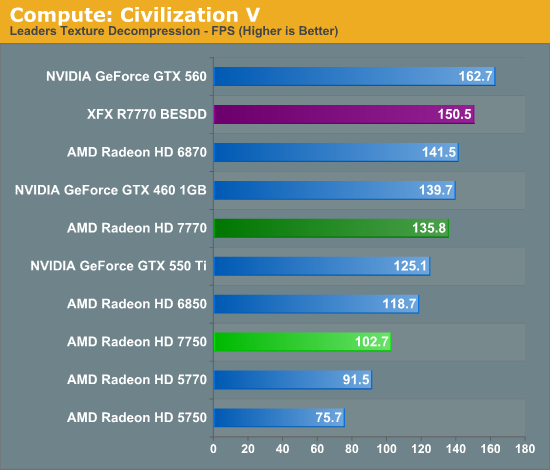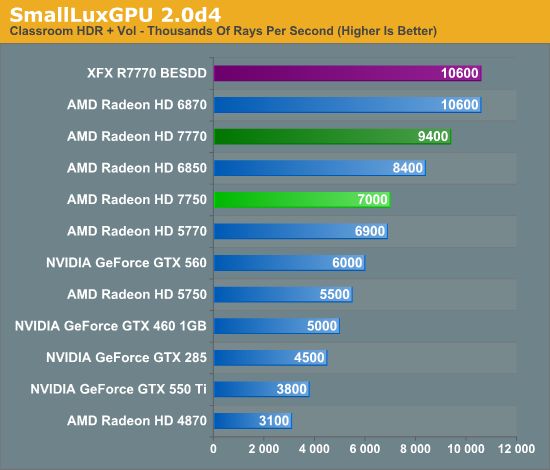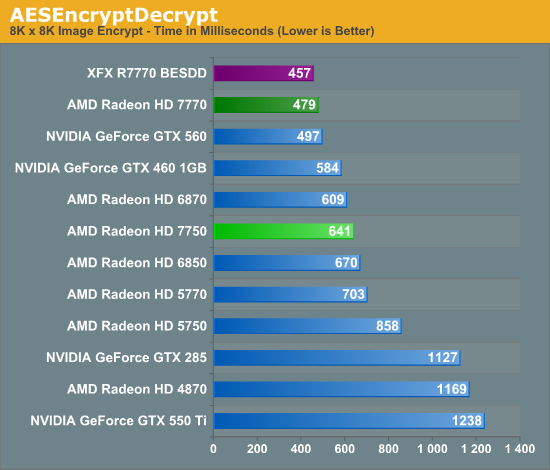AMD Radeon HD 7750 & Radeon HD 7770 GHz Edition Review: Evading The Price/Performance Curve
by Ryan Smith & Ganesh T S on February 15, 2012 12:01 AM EST- Posted in
- GPUs
- AMD
- HTPC
- GCN
- Radeon HD 7000
Compute Performance
Moving on from our look at gaming performance, we have our customary look at compute performance. With GCN AMD significantly overhauled their architecture in order to improve compute performance, as their long-run initiatives rely on GPU compute performance becoming far more important than it is today.
With such a move however AMD has to solve the chicken and the egg problem on their own, in this case by improving compute performance before there are really a large variety of applications ready to take advantage of it. As we’ll see AMD has certainly achieved that goal, but it raises the question of what was the tradeoff for that? We have some evidence that GCN is more efficient than VLIW5 on a per-shader basis even in games, but at the same time we can’t forget that AMD has gone from 800 SPs to 640 SPs in the move from Juniper to Cape Verde, in spite of a full node jump in fabrication technology. In the long run AMD will be better off, but I suspect we’re looking at that tradeoff today with the 7700 series.
Our first compute benchmark comes from Civilization V, which uses DirectCompute to decompress textures on the fly. Civ V includes a sub-benchmark that exclusively tests the speed of their texture decompression algorithm by repeatedly decompressing the textures required for one of the game’s leader scenes. Note that this is a DX11 DirectCompute benchmark.

Theoretically the 5770 has a 5% compute performance advantage over the 7770. In practice the 5770 doesn’t stand a chance. Even the much, much slower 7750 is ahead by 12%, meanwhile the 7770 is in a class of its own, competing with the likes of the 6870. The 7770 series still trails the GTX 560 to some degree, but once again we’re looking at the proof of just how much the GCN architecture has improved AMD’s compute performance.
Our next benchmark is SmallLuxGPU, the GPU ray tracing branch of the open source LuxRender renderer. We’re now using a development build from the version 2.0 branch, and we’ve moved on to a more complex scene that hopefully will provide a greater challenge to our GPUs.

SmallLuxGPU is another good showing for the GCN based 7700 series, with the 7770 once again moving well up the charts. This time it’s between the 6850 and 6870, and well, well ahead of the GTX 560 or any other NVIDIA video cards. Throwing in an overclock pushes things even farther, leading to the XFX BESDD tying the 6870 in this benchmark.
For our next benchmark we’re looking at AESEncryptDecrypt, an OpenCL AES encryption routine that AES encrypts/decrypts an 8K x 8K pixel square image file. The results of this benchmark are the average time to encrypt the image over a number of iterations of the AES cypher.

Under our AESEncryptDecrypt benchmark the 7770 does even better yet, this time taking the #2 spot and only losing to its overclocked self. PCIe 3.0 helps here, but as we’ve seen with the 7900 series there’s no replacement for a good compute architecture.
Finally, our last benchmark is once again looking at compute shader performance, this time through the Fluid simulation sample in the DirectX SDK. This program simulates the motion and interactions of a 16k particle fluid using a compute shader, with a choice of several different algorithms. In this case we’re using an (O)n^2 nearest neighbor method that is optimized by using shared memory to cache data.

It would appear we’ve saved the best for last, as in our fluid simulation benchmark the top three cards are all 7700 series cards. This benchmark strongly favors a well organized cache, leading to the 7700 series blowing past the 6800 series and never looking back. Even NVIDIA’s Fermi based video cards can’t keep up.










155 Comments
View All Comments
Oxford Guy - Wednesday, February 15, 2012 - link
What I'd like to know is why the 7950 is shown in the Idle temp charts and then vanishes from the Load temp charts.Oxford Guy - Wednesday, February 15, 2012 - link
Sorry.. Power consumption charts.I'd like to see the 7950/7970 load power consumption. The idle consumption is less interesting and that's where they're shown.
dananski - Wednesday, February 15, 2012 - link
Me too, the 6850 was worse than the 5850, so I'd expected it to be easily beaten by this generation's 770. Then again, the 6770 was just a 5770, so I suppose I should've learned that the mid-range is barely moving.designerfx - Thursday, February 16, 2012 - link
if you think about the fact of it's price today then it will probably be down substantially in a month - at which point it'd be quite competitive.ce12373 - Wednesday, February 15, 2012 - link
Hmmm. This AMD story sounds like a lot of other AMD stories (cough*cough "BULLDOZER"). Maybe no one has piledriven the point home to AMD yet. Oh well.medi01 - Wednesday, February 15, 2012 - link
Right, and it's a long time that nVidiai stopped producing overpriced "you can fry pancackes with these" GPUs and even hold performance crown? Oh, it's still producing them and AMD still hold performance crown? What a pity.Oh, but AMD went nVidia route with "confuse consumer more" naming scheme? How shameless, do they pay royalties for this to nVidia, the inventor of this rubbish?
aguilpa1 - Wednesday, February 15, 2012 - link
AMD has been doing the name bait and switch just as long as Nvidia but since your such a fan boy apparently you haven't noticed. It is obvious from your overheated GPU remarks that you are stuck on some ancient review of a past Nvidia product. And again, AMD has done the same, also in the past, 2900XT anyone?CeriseCogburn - Wednesday, March 21, 2012 - link
The GTX 590 still holds the single card crown.The very strange situation that has occurred is amd holding the single core card crown with 7970, finally passing the 580 after a year or closer to two and I don't remember how long.
This single core crown is gone already gone with the GTX680 benches leaked a few days early.
So amd finally did hold a crown for once in a very long time, for a very short time, 2.5 months or so....with most of that time in very weak or absent stock on retail shelves.
Spunjji - Thursday, June 21, 2012 - link
BLAH BLAH BLAH BLAH BLAHReticence - Monday, June 24, 2013 - link
You realize you're kinda the laughing stock of anandtech right? You wait with baited breath for every post remotely including AMD somewhere in the article to give you the opportunity to suck off nvidia and intel. I literally think you might need psychiatric help with that raging superiority complex, then again I've always thought there should be specially designed concentration camps for people like you who never grew out of acting like a blow-hard highschool kid.Oh well, down to business.
Two 7970's (And I mean two 7970's, NOT a 7990) perform better than one Titan, EVERY benchmark has shown it, you can not deny this. And I already know what you're doing to say "BUT THAT'S 2 CARDS VS. 1, NOT FAIR ;[" But see, this is the main point that proves you're a major fucking moron. That.does.not.matter.at.all.
The the Titan is 1000$.
Two 7970's are 800$.
And while yes, it's impressive that a single card can hold it's own against two, it doesn't matter, who is going to spend 200$ more for LESS performance? I'm sure you'll also say "you're just an AMD fanboy." Wrong, I just don't like to waste my money. And I really, really, don't like you.
Nuff said.
Oh and by the way, read it and weep, pussy.
http://www.semiaccurate.com/forums/showpost.php?p=...″